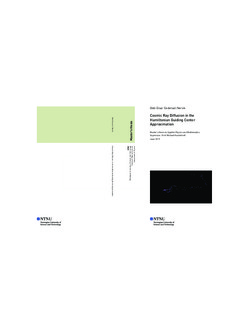| dc.contributor.advisor | Kachelrieß, Michael | |
| dc.contributor.author | Nervik, Odd-Einar Cedervall | |
| dc.date.accessioned | 2019-10-29T15:00:44Z | |
| dc.date.available | 2019-10-29T15:00:44Z | |
| dc.date.issued | 2019 | |
| dc.identifier.uri | http://hdl.handle.net/11250/2625256 | |
| dc.description.abstract | Forå konstruere en metode tilå teste nøyaktigheten til den Hamiltonske føringssen-
terapproksimasjonen undersøkes diffusjonskoeffisientene av kosmiske stråler propa-
gert i et turbulent magnetisk felt. Målet er å reprodusere tidligere resultater for å
forsikre at diffusjonssimuleringene kan benyttes til å sammenligne den Hamiltons-
ke føringssenterapproksimasjonen opp mot det å løse Lorentz-ligningen direkte.
Turbulensen simuleres som en hydrodynamisk turbulens som følger Kolmogorov’s
energispektrum. For å simulere propagasjonen av kosmisk stråling ble en Runge-
Kutta-integrator implementert for å løse Lorentz-ligningen. Isotropien av algorit-
men som genererer det turbulente magnetfeltet verifiseres, og isotropien i feltet
bevises gitt at korrekt sannsynlighetsfordeling for de tilfeldige fasene velges. Vi-
dere vises den kvalitative atferden av diffsjonskoeffisientene å være i samsvar med
tidligere resultater. Etter overgangen til det isotropiske regime finnes faktoren
d 3 /d 1 til å være tilnærmet konstant ved d 3 /d 1 ∼ 10, som viser en signifikant aniso-
tropisk atferd. Sammenligning av de gjennomsnittlige diffusjonskoeffisientene fra
simuleringene opp mot de teoretiske verdiene viser at forskjellen er innen en faktor
mellom 1.21 og 2.33. Diffusjonskoeffisienten vises å følge D(E) ∝ β som forventet,
med β = 1/3 og β = 2 for the diffusive og det ballistiske regime respektivt. Videre
vises det at overgangen mellom de to regimene starter ved høyere energi for de
simulerte diffusjonskoeffisientene enn for de teoretiske koeffisientene.
Hamiltonsk føringssenterteori anvendes på propageringen av kosmisk stråling
gjennom forskjellige magnetiske felt, inklusive det uniforme feltet, spiralfelt med
konstant og varierende feltstyrke, samt et uniformt felt i superposisjon med et
turbulent felt. Målet er å teste under hvilke forhold føringssenterteorien kan brukes
i stedet for å løse Lorentz-ligningen direkte, og fortsatt gi ekvivalente resultater.
Videre testes det om føringssenterteorien øker effektiviteten i disse simuleringene.
Det vises at føringssenterteorien reproduserer en tilsvarende bane til den pro-
dusert av den eksakte løsningen, med unntak av drifteffekter påført av curlen til
magnetfeltet, samt en akselerasjonseffekt påført av magnetfeltets gradient. Disse
manglende effektene vises å komme av en feil i programmeringen av teorien. Resul-
tatene peker mot at Hamiltonsk føringssenterteori, når den implementeres korrekt,
vil simulere banene til kosmisk stråling gjennom det Galaktiske magnetfeltet med
høy nøyaktighet. Simuleringene antyder også at føringssenterteorien vil være mer
effektiv enn å løse Lorentz-ligningen direkte.
Siden implementasjonen av føringssenterteorien ikke ble ferdigstilt inne tids-
rammen av dette prosjektet, var det ikke mulig å implementere den i beregningene
av diffusjonen av kosmisk stråling i det galaktiske magnetiske feltet. | |
| dc.description.abstract | To provide a method of testing the accuracy of the Hamiltonian Guiding Center
Approximation, the diffusion coefficients of cosmic rays propagating in a purely
turbulent magnetic field is investigated. The goal is to reproduce earlier results to
assure the diffusion simulations can be used to compare the Hamiltonian guiding
center theory to the direct solving of the Lorentz-equation. The turbulence is sim-
ulated as a hydrodynamic turbulence following the Kolmogorov power spectrum.
To simulate the cosmic ray propagation a step-size controlled Runge-Kutta algo-
rithm is implemented to solve the Lorentz-equation. The isotropy of the algorithm
generating the turbulent magnetic field is verified, and isotropy is proven given the
correct choice of probability distribution for the random phases. Furthermore, the
qualitative behavior of the diffusion coefficients is shown to be in accordance with
previous results in both the isotropic and anisotropic regimes. After transitioning
to the isotropic regime the factor d 3 /d 1 is found to be constant at d 3 /d 1 ∼ 10,
which shows a significant amount of anisotropic behavior. Comparing the am-
plitude of the average diffusion coefficients from the simulations with theoretical
coefficients show that they are within a factor of 1.21 and 2.33. The scaling of
the diffusion coefficient is found to follow the expected D(E) ∝ β when β = 1/3
and β = 2 for the diffusive and ballistic regimes respectively. The transition is
shown to begin at a slightly higher energy for the simulated diffusion than for the
theoretical diffusion.
Hamiltonian guiding center theory is applied to the propagation of cosmic rays
through different magnetic field models, including the uniform field, spiral fields
with constant and non-constant field strengths, and a uniform field in superposition
with a turbulent field. The aim is to test under which conditions the Hamiltonian
guiding center theory can replace the direct solution of the Lorentz-equation and
still provide equal results. Furthermore it is tested whether the guiding center
theory is able to increase the efficiency of these simulations.
It is shown that guiding center theory accurately reproduces the equivalent
trajectory to that of the direct solution of the Lorentz-equation, exempt of a drift
velocity caused by the curl of the magnetic field and an acceleration caused by the
gradient of the magnetic field strength. The exemption of these effects are shown to
be missing due to errors in the implementation. The presented results suggest that
the Hamiltonian guiding center theory, when implemented correctly, will be able
to accurately simulate the trajectories of cosmic rays through a Galactic magnetic
field. The simulations using the guiding center theory also suggest the theory will
be more efficient than directly solving the Lorentz-equation.
As the guiding center theory implementation was not completed within the
time frame of this project, it was not possible to implement it in the simulation of
diffusion of cosmic rays in the Galactic magnetic field. | |
| dc.language | eng | |
| dc.publisher | NTNU | |
| dc.title | Cosmic Ray Diffusion in the Hamiltonian Guiding Center Approximation | |
| dc.type | Master thesis | |
